The first Norton Commando rolled off the line at the end of 1967, but we actually have to go back many years in time to find the roots of this machine. In the 1948s, Bert Hopwood designed the Dominator. This was released in 750 and evolved over the years into the Atlas. It is this one that, with its XNUMX cc, can safely be referred to as the predecessor of the Commando.
The engine had become heavier over the years, but in the end this resulted in a block that produced a lot of vibrations. These were not only a nuisance, but the reliability eventually suffered. In addition, the featherbed frame had come to the end of its evolution and there was an urgent need to look for something better. At first, Norton thought of developing the prototype further under the name “P10”, but that soon turned out not to be the right choice.
Of course, vibrations are a nuisance, but they are also inherent in the principle of the standing parallel twin. And because people did not want to deviate from this concept on principle, people must have thought: if you can't avoid them, you can perhaps cover them up a bit.
Three months before the opening of the 1967 Earles Court Motor Show, Bernard Hooper and Bob Trigg were tasked with developing a new frame as quickly as possible to minimize vibrations. The result was very simple: you simply hang the block in rubber: the “iosolastic” was born. The axles with which the block was mounted in the frame were fitted with a rubber casing so that vibrations were not transmitted to the frame.
The Norton Commando fastback
The first model of the Norton Commando was presented in 1967 at the Earles Court Motor Show. We now know this as the Norton Commando “Fastback”, but that was a name that this machine only got later. Incidentally, it was the rather remarkable shape of the plastic part behind the seat that gave the machine its nickname. For collectors, this is the model to have in the garage.
The Norton Commando was an instant success and was named “Machine of the Year” by the folks at Motor Cycle News. The first models are best recognizable to a layman by the drive of the tachometer located in front of the block and the placement of the contact points, behind the block, together with the drive of the magneto. The block itself had a displacement of 749,99 cc and although it was a descendant of the Atlas, there were quite a few differences.
For example, the cylinders tilted slightly forward, almost parallel to the front frame tubes. The gearbox of the Norton Commando was still separate from the crankcase, but you could hardly expect otherwise from a “good old English machine”. In the years that followed, the machine also remained in the favor of journalists, because it was voted favorite of the year three years in a row, the British are sometimes said to be quite conservative. How could that be?
In 1970 the first thorough changes were made, the Norton Commando MKII now had the contact points at the front of the block and therefore the tachometer drive had to be moved a bit. For the first time, you also had a choice of a number of extra versions. You had the "roadster" model, characterized by the somewhat smaller gas tank, normal saddle without plastic piece and a higher handlebar.
Then there was the “S” model of the Norton Commando, with the two exhausts one above the other, rising up the left side of the machine and terminating in two superimposed mufflers with heat shields. However, this model did not last long, because it already disappeared in 1971. Both variations were mainly intended for the American market.
In the meantime, some organizational changes had also been made. Where in the beginning everything was produced in the AMC factory in Plumstead, this was later split up from 1969. The Norton Commando's engines and gearbox were assembled in Wolverhampton and then transported 180 miles to Andover where they were built into the frame. Not exactly an example of how it should be done, but it did have the advantage that final assembly was not far from the Thruxton circuit and some testing was soon done before improvements could be made.
Norton Commando on the sporty tour
In 1971 the MKIII came out, with a somewhat softer drive because extra buffers were installed in the rear wheel. The front fork of this third model of the Norton Commando was also improved and the switches were now sourced from Lucas.
You could find a few special versions of this model, such as the "Street scrambler", a semi-off-road version, at least and the Fastback Long Range, the latter referring to the larger fuel tank, so that you could drive a little further with a tank of gasoline. In addition, you also had the “High-rider” with higher handlebars and finally the “Production Racer”, built in collaboration with Norvil Performances.
The latter was characterized by a different camshaft, larger valves, a higher compression ratio and tuned block with the associated extra power of course. To dress it all up, the model got clip-ons, a sporty tank seat combination, steering cockpit and you had the option for disc brakes and a close-ratio gearbox. The machine therefore became a formidable opponent in many distance races such as the Thruxton 500.
The Norton Commando MKIV received the same models, but the block had undergone some internal changes. There was also a touring machine, the Interstate, which, just like the Roadster, could be supplied with a tuned Combat block. The latter did not really turn out to be a success. The increase in horsepower had a serious impact on reliability and if it's one thing long distance riders insist on, it's that the machine can grind down miles without a hitch.
The blocks already delivered were therefore quickly reduced to a standard version and the associated costs rose considerably. The block had therefore reached its limit and the Norton Commando MKV model from 1973 would become the last 750cc in the line. Meanwhile Norton, like most British motor companies for that matter, was not doing very well and the Norton-Villiers-Triumph group was born which would cause quite a few changes.
From 1973 the Norton Commando MKI 850 was added to the program. By increasing the bore from 73 to 77 mm, a cylinder capacity of 829 cc was achieved and all types were now equipped with disc brakes. To promote the model, they also teamed up with the John Player Tobacco and a number of factory machines were created intended for the formula 750 races.
The super-tuned block delivered no less than 80 hp at 8000 rpm and after many successes a replica appeared on the market, listening to the name John Player Special. Only 250 were built and they are clearly recognizable by the white fairing, race butt, clip-ons and matte black exhausts, so a real collector's item. But be careful, there are replicas of this replica on the market.
The End
Norton Commando's standard model, meanwhile, didn't fare as well. Not that the machine itself wasn't up to par: only the competition, especially from the Japanese, had become cutthroat. So it had to be modernized and from 1975 you could also opt for an electric starter, you got disc brakes both front and rear, and, something that will certainly have disturbed the traditional Briton, the gear shift pedal moved to the left side of the block.
The other European and American customers were of course only too happy to see this happen and had to cope with the difficult switching. The press was not really impressed with the machine. A number of shortcomings had been eliminated, but these were more than insufficient to make up for all the backlog.
Those who wanted to drive with a legend only had to take a few minuses, you could read then. The end of an era was therefore in sight, financial problems were getting heavier, there was not enough money for thorough research and people were falling further and further behind. There was still a prototype with cast wheels, but they didn't get any further than that and in 1977 the last Commando rolled off the production line.
As a classic?
However, a lot has changed since then, classics are now in and used. But use also means that parts are needed and in the meantime there are companies that supply parts for these models. There are even companies that can deliver as good as new, or should we even say, new Commandos to order.
The model can therefore be used on a daily basis. Not that this is responsible, because it is and remains a machine that is more than thirty years old and that has its limitations. For example, you should not compare the disc brakes with the ones you now find on modern machines, but those who take to the road “as a good family man” will not regard this as a nuisance. The first 750 models are the fastest and lightest in the range, top of 192 per hour and 198 kg on the scales while the last, the 850 models, only reached 185 per hour and registered 225 kg.
Driving a Norton Commando
A short test drive with a few of these machines surprised me positively. The vibrations remain well below the allowable, the driving behavior is therefore more than decent, but especially the acceleration is impressive.
The block picks up very quickly from a very low speed and even a modern machine has to work hard to keep up with this. Once in the revs that is of course something else, but we are not going to venture into that. You have to treat a classic with respect and going to the extreme is not part of that. Quiet revs are therefore perfect for the machine, you have to do very little switching, the machine drags you through everything and from 1500 rpm it goes 'fast'.
Especially in times of flash cameras, I like this even more than a sporty modern high-speed machine where you have to constantly watch the counter. The Norton Commando is a wolf in sheep's clothing, looks good and stays that way until you get on the gas. Then you notice that he has a lot of potential. Not surprising that the model still has a lot of support from enthusiasts. You can easily cover long distances along the motorway, but you can also take it for a quiet ride on winding tracks. An all-rounder, you can put it that way.
The fashion models
The black 'fastback ' van William comes from the United States, dates from 1969 and has been providing the owner with a lot of driving pleasure since 1994. Unfortunately, he recently found out that the parts are still readily available when it turned out that the cylinder was torn at the bottom. A set of new cylinders and pistons could be ordered without any problem and are currently being run-in. It wasn't cheap, however. It cost him € 900 in parts.
The yellow Norvil was built by Etienne, a Harley man in heart and soul, but he used to drive on the circuit with this kind of machines via the Belgian importer Podevijn and could not resist preparing a machine that was as good as new. The Norvil kit was the last original still available and was transplanted onto a 750 1971 Commando, with Combat block.
This article was copied 1 on 1 from AMK 6 of 2008. Still standing Auto Motor Klassiek every month packed with fun, interesting and captivating stories about classic cars and their owners. If you don't have that yet, or don't have it anymore, grab the chance now and score another great deal AMK annual subscription. That also saves you enough for a few extra liters of petrol, even at current prices, which just happened to have risen today.
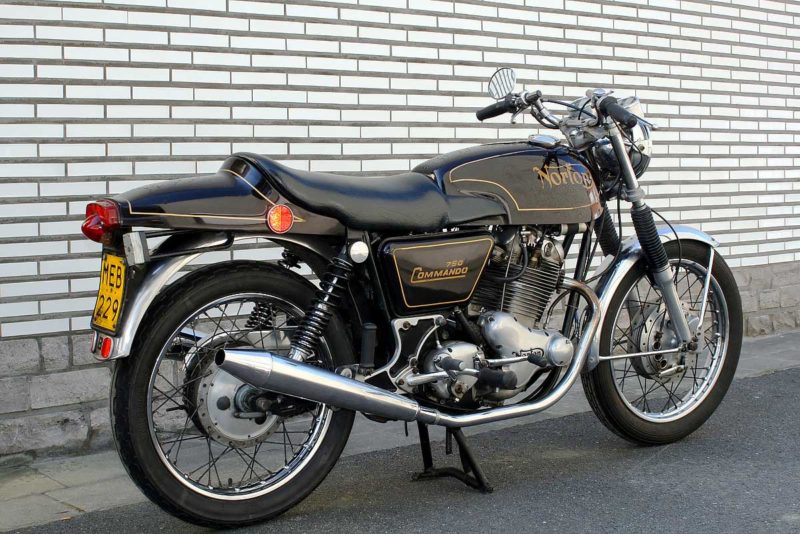



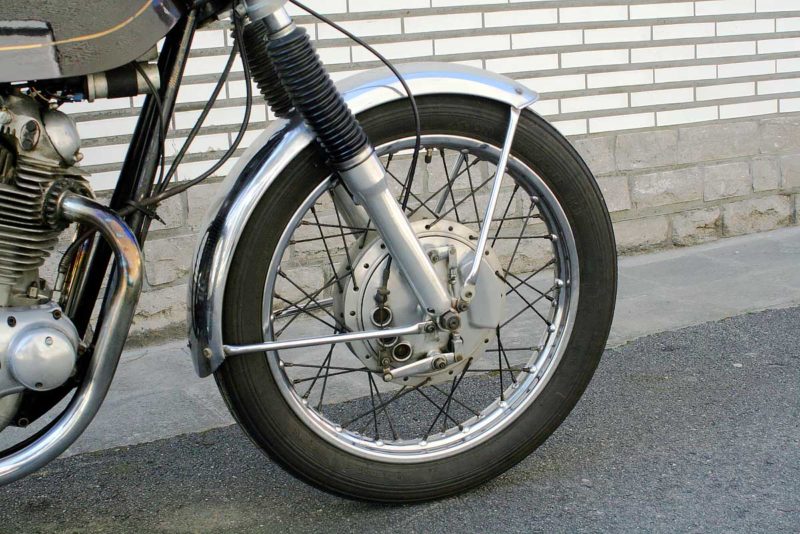
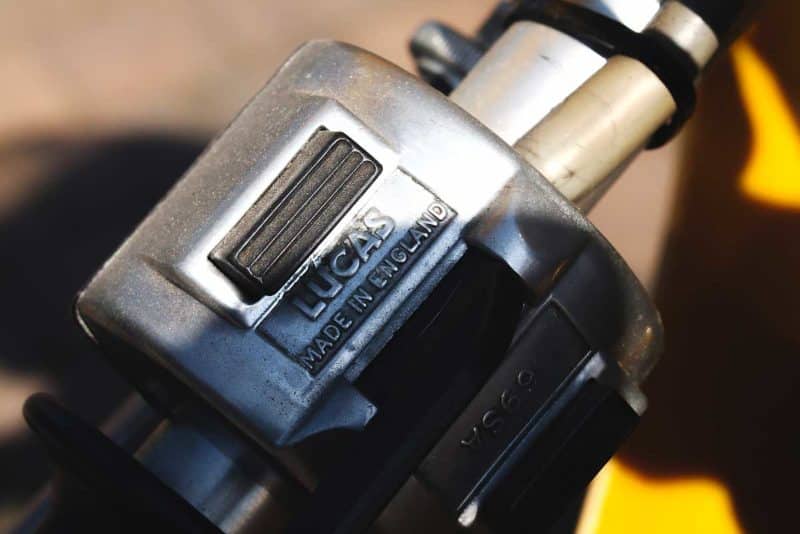
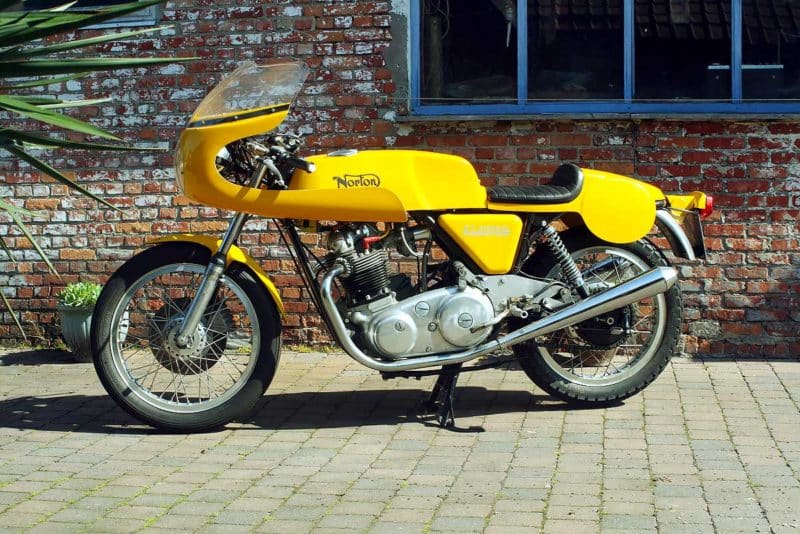


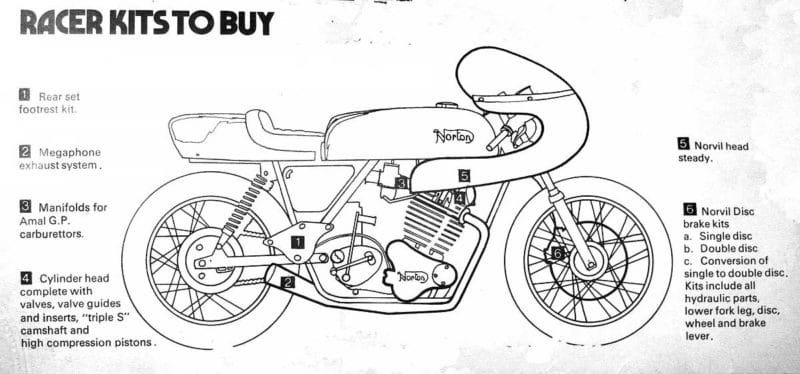


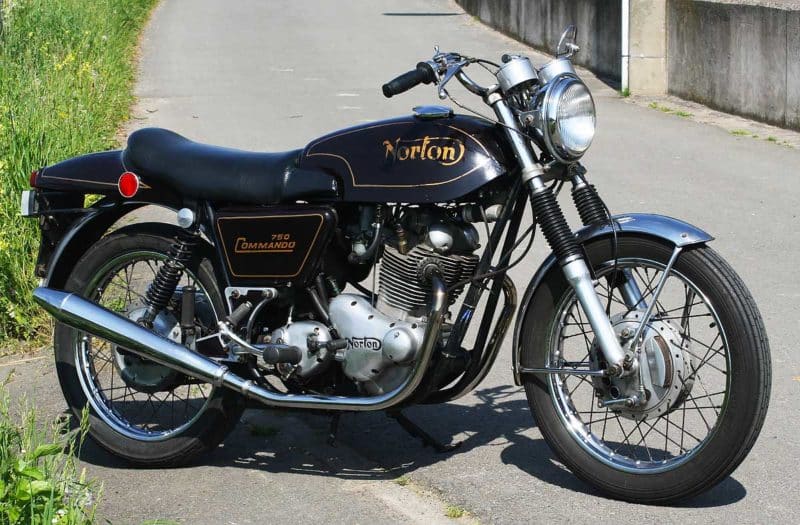

I also bought a used 1975 mk iv interstate in 850 with a small red tank and lucas switches, few km on the clock, bought from a man who had to get rid of his motorcycle because of the arrival of a new member, price € 2.650 somewhere cold in November overijsel, so we went home on the motorcycle in the north of Holland, came home first stood against the heater for half an hour, had turned 4 on the way, checked properly two days later ??? indeed elastic rubbers, the vibration was not too bad, but the fork legs did vibrate, I had a lot of fun with it, regularly change the oil and oil filter, such a screw thing later, problems with the oil lubrication, the block was taken apart by a dealer ??? turned out to be a known problem OIL CHANNELS TOO SMALL, so block overhauled and sold JAMMER YOU KNOW was quite a nice bike, still think of it as one of my favorites
In 1977, at 17 years old, I bought a commando interstate. The previous owner had built an electronic ignition on it, but it had no advance at that time. The result can be guessed, the kickstarter was able to hit back very hard with kicking, so hard that the best man broke his ankle. So the engine had to go. So a lot of work had to be done. I haven't driven it that much, but tinkered with it all the more. He did have a habit of letting you know in time that something was about to break so that you always came home. Particularly nice. The list of fixes/anecdotes is very long. Like the time the engine suddenly pulled very much to the left. Turned out to be the odometer drive that is stuck on the rear wheel. This twisted the cable around the rear axle and pulled the handlebars to the left. Well. I have never been able to bring myself to sell the bike and it is still in the garage, unfortunately it has been standing still for 35 years. Now have a kawasaki w800, look it up.
Pim
A great story. And very nice that you still have the bike you bought when you were 17. Let's hope it comes out of the shed and is made to walk again.
Thoroughly enjoyed my 70 Commando in the mid 850s. Lots of torque from low revs. Really very comfortable on longer journeys and highway. Absolutely little perceptible vibration for a standing Twin. And: extremely reliable, if ridden with love: applies to almost every motorcycle. Eventually exchanged for a Honda CX 500 Turbo: also had a lot of fun with this. Rightly so, the Commando is now a coveted classic.
My dad had bought an 850 MKIII in London in 1975, and I bought it from him in 1985. Electric starter works! Going up from 1500, even in fourth, remains a special experience!
What a beauty !!!
At the uni I had a 750 commando later equipped with special parts (Wiseco pistons, stage 1 cam, other valve springs, etc. This was very fast up to 120 but still rideable. So sorry I didn't keep up with it. Sold to a police motorcyclist who this could taste